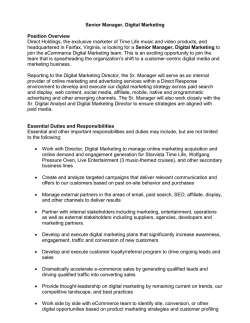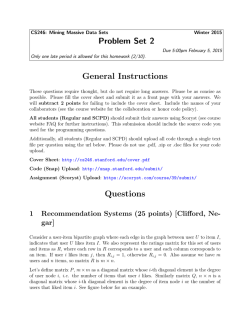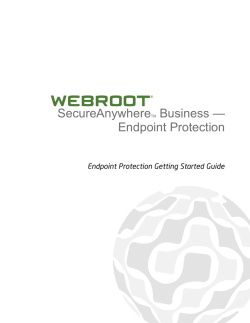
Subject and objects Access operations Access control structures
2015-01-29
Subject and objects
Access operations
Access control structures
Intermediate controls
Lattice of security levels (multi-level security)
Why do we need access control?
Confidentiality, a user should be able to deny other
users read access to his files
Integrity, a user should be able to protect his files from
modification or deletion by other users
Help users to avoid unintentional change of important
system files
Help users to avoid unintentional change of important
personal files, e.g., photos
EIT060 - Computer Security
Subject (active)
Object (passive)
Access operation
Reference monitor
1
users, processes, …
files, resources, …
read, write, …
grants/denies access
EIT060 - Computer Security
2
Subject/Principal
◦ A principal is granted or denied access, e.g., UID
◦ A subject acts on behalf of the principal, e.g., process running under a UID
◦ NOTE: In some litterature only subject is used
Subject/Object
◦ A subject is the active party
◦ An object is the passive party
◦ Note that an entity can be subject in one request but object in another
Access Right
◦ Describes in which way a subject may access an object
Subject/
Principal
Access
request
Reference
monitor
EIT060 - Computer Security
object
Access Control can focus on one of two things:
3
1.
What a subject is allowed to do
2.
What may be done with an object
EIT060 - Computer Security
4
1
2015-01-29
Elementary level:
Observe: look at the contents of an object
Alter: change the contents of an object
This is often too general to be practical
object
Access rights
Bell-LaPadula security model:
Execute, Append, Read, Write
Execute Append
Observe
Alter
X
Read
X
Write does not imply read
read
Read file
write
Write file
execute
Write
X
X
File
Directory
List directory
contents
Create/Delete/
Rename a file
Execute program Search directory
Relation between Bell-LaPadula access rights and elementary access modes
EIT060 - Computer Security
5
Discretionary access control – The owner of an object
decides the access rights
Mandatory access control – The system decides the
access rights
EIT060 - Computer Security
Access rights individually defined for each subject
and object
Let
◦ S: the set of subjects
◦ O: the set of objects
◦ A: the set of access operations
Orange Book:
◦ Discretionary access control – Access is restricted based on the
identity of the subject
◦ Mandatory access control – Access is restricted based on the
information sensitivity of an object and the authorization level
of a subject.
EIT060 - Computer Security
6
The access rights are uniquely defined by the access
control matrix, M=(Mso) with Mso⊆A, sS, oO
Alice
Bill
Charlie
7
Bill.txt
Edit.exe
Prog.php
{read}
{execute}
{read,execute}
{read,write}
-
{read}
{read}
-
EIT060 - Computer Security
8
2
2015-01-29
Abstract concept
◦ Size of matrix will be large
◦ Much redundancy. (Many empty entries, many entries that are
the same)
◦ Creation and deletion of objects difficult to manage efficiently
Alice
Bill
Charlie
Bill.txt
Edit.exe
Prog.php
{read}
{execute}
{read,execute}
{read,write}
-
{read}
{read}
-
-
Alice’s capability: Bill.txt: read; Edit.exe: execute; Prog.php:read,execute
Bill’s capability: Bill.txt: read,write; Prog.php: read
Charlie’s capability: Bill.txt: read
Two alternatives
Access Control List
Store access rights
with objects
Capabilities
Store access rights
with subjects
Difficult to determine who has access to a given object
EIT060 - Computer Security
Separate each row
9
EIT060 - Computer Security
Separate each column
10
Putting users into a group can simplify
Beware of policy conflicts!
Alice
Bill
Charlie
Bill.txt
Edit.exe
Prog.php
{read}
{execute}
{read,execute}
{read,write}
-
{read}
{read}
-
-
u1
u2
u3
G1
ACL for Bill.txt: Alice: read; Bill: read,write; Charlie: read;
ACL for Edit.exe: Alice: execute
ACL for Prog.php: Alice: read, execute; Bill: read
o1
o2
u4
u5
u1
u2
G2
o3
u3
G1
o4
o1
o2
u4
u5
G2
o3
o4
Should u1 get access to o1?
Difficult to get an overview of an individual user’s permissions
EIT060 - Computer Security
11
Denying access may not be the same as not allowing access
EIT060 - Computer Security
12
3
2015-01-29
Principle of least privilege
◦ A user or process should only have access to resources that are necessary
More stability – processes can not affect each other more than
necessary and only affect a limited part of the system
More security – Vulnerabilities on one application can not be used to
exploit other parts of the system
Example:
User + current job → role
Motivation: Users come and
go, roles can be kept more
static
Role 1
Common in database
Role 2
Role 3
management systems
Separation of duties
◦
◦
◦
◦
Security critical functionality must be performed by more than one user
Prevents fraud and errors
Sometimes difficult to achieve
Example: designer/implementer should not
be same as tester
◦ Example 2: Control of nuclear missile launch
EIT060 - Computer Security
Access rights are derived
from a user’s current role
Role n
13
User 1
User 2
User 3
User 4
User 5
׃
User m
Role 1 Role 2 Role 3 … Role n
X
X
X
X
X
X
X
X
X
Object 1 Object 2 Object 3
owner
modify
stop, start
append
read
start
Object k
copy
read
defrag
EIT060 - Computer Security
14
RBAC3
RBAC0: Base model
◦ User, roles, permission, session
RBAC1
RBAC0
Director
Manager Manager
project 1 project 2
RBAC3: RBAC1 + RBAC2
Manager
project 3
Engineer
◦ Combining hierarchies with constraints
Set of security levels L
A partial ordering ≤ on a set L is a relation on L x L
which is
◦ Reflexive: a ≤ a, for all a L
◦ Transitive: if a ≤ b and b ≤ c then a ≤ c, for all a L
◦ Antisymmetric: if a ≤ b and b ≤ a then a=b, for all a L
RBAC2: Constraints
◦ Mutually exclusive roles (separation of duties)
◦ Cardinality (e.g., only one manager per project,
only a certain number of roles for each user)
◦ Prerequisite (You must have a subordinate role –
allows implementation of least privilege)
RBAC1: Role Hierarchies
◦ Allow inheritance
RBAC2
Example:
◦ Powerset P(X) with subset relation as partial ordering
Thesis worker
RBAC1 example
EIT060 - Computer Security
15
EIT060 - Computer Security
16
4
2015-01-29
The powerset P(X) is the set of all subsets of the set X.
Let X = {x,y,z}
Then
P(X) = { {∅}, {x}, {y}, {z}, {x,y}, {x,z}, {y,z}, {x,y,z} }
We can define the partial ordering (P(X), ⊆)
We have e.g.,
◦ {x} ≤ {x,y}
◦ {x,y} ≤ {x,y,z}
◦ Note that there is no ordering between e.g., {x} and {y,z}
Graphical representation of a partially ordered set
There is an edge between node a and b if and only if
◦ a ≤ b and a ≠ b
◦ There is no c ∈ L so that a ≤ c ≤ b and a ≠ c, b ≠ c
We can say that a subject can access an object if object’s label
is a subset of the subject’s label
Example: Hasse diagram
of partially ordered set
(P({x,y,z}), ⊆)
◦ Subject with label {x,y} can access object with label {x} since {x} ≤
{x,y}
EIT060 - Computer Security
17
A lattice can answer two questions:
◦ Given two objects at different security levels, what is the minimal
security level a subject must have to access both?
◦ Given two subjects at different security levels, what is the maximum
security level an object can have so that it can be accessed by both
subjects?
Definition: A lattice (L, ≤) consists of a set L and a partial
ordering ≤. For a, b L there is a least upper bound u L and
a greatest lower bound l L.
We say that b dominates a if a ≤ b
Powerset with subset relation as partial ordering is a lattice
EIT060 - Computer Security
18
Example of least upper bound u
◦ Let a = {x} and b = {z}
◦ Then u = {x,z}
◦ {x} ≤ {x,z} and {z} ≤ {x,z} and for all elements v such that
a ≤ v and b ≤ v we also have u ≤ v
◦ In this case {x,z} and
{x,y,z} are the only
elements that dominates
{x} and {z} and clearly
{x,z} ≤ {x,z} and {x,z} ≤
{x,y,z}
◦ a ≤ u, b ≤ u, and ∀v ∈ L : (a ≤ v ∧ b ≤ v) ⇒ (u ≤ v)
◦ l ≤ a, l ≤ b, and ∀k ∈ L : (k ≤ a ∧ k ≤ b) ⇒ (k ≤ l)
EIT060 - Computer Security
19
EIT060 - Computer Security
20
5
2015-01-29
Example of greatest lower bound l
◦ Let a = {x,y} and b = {x,z}
◦ Then l = {x}
◦ {x} ≤ {x,y} and {x} ≤ {x,z} and for all elements k such that
k ≤ a and k ≤ b we also have k ≤ l
◦ In this case {x} and {∅}
are the only elements that
are dominated by {x,y}
and {x,z} and clearly {x}
≤ {x} and {∅} ≤ {x}
EIT060 - Computer Security
Linear ordering
Top Secret
Secret
Confidential
Unclassified
Combine with a set of categories to
make it more flexible:
H is a set of classifications
C is a set of categories
Security level is (h,c), h H, c C
Partial ordering:
(h1,c1) ≤ (h2,c2) iff h1 ≤ h2 and c1 ⊆ c2
21
Example of lattice
EIT060 - Computer Security
22
Three similar concepts
◦ 2 classifications: public and private
◦ 2 categories: A and B
private, {A,B}
Reference monitor: Abstract machinery that controls
all access to objects.
Security kernel: the hardware, software etc. that
implements the reference monitor concept.
Trusted computing base (TCB): The set of all
protection mechanisms enforcing a security policy
private, {A}
private, {B}
(public, {A}) ≤ (private, {A})
(public, {B}) ≤ (public, {A,B})
(public, {B}) ≰ (private, {A})
private, {∅}
public, {A,B}
public, {A}
public, {B}
public, {∅}
EIT060 - Computer Security
23
EIT060 - Computer Security
24
6
2015-01-29
Reference monitor writes to
the audit log
Audit
Requirements
◦ Tamper proof
◦ Must always be invoked
◦ Small to allow analysis
Reference
monitor
Subject
Object
Where should we place it?
◦
◦
◦
◦
Reference monitor checks if
subject has access to object
Hardware
Operating system
Service layer (e.g., JVM)
Application
Security
kernel
database
Database includes classifications of objects
EIT060 - Computer Security
A user wants to execute an operation requiring specific access rights
(which the user does not have)
Use an API in order to execute the operation
The system only performs a predefined set of operations
25
EIT060 - Computer Security
26
◦ supervisor mode.
Enough access rights
Not enough access rights
API
user
system
•
•
•
•
Open file
change password
manage printer queue
Etc…
EIT060 - Computer Security
27
7
© Copyright 2025






